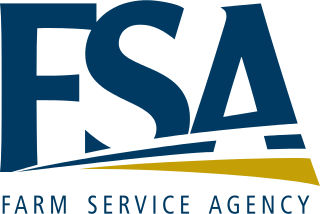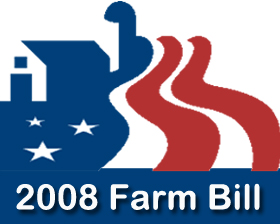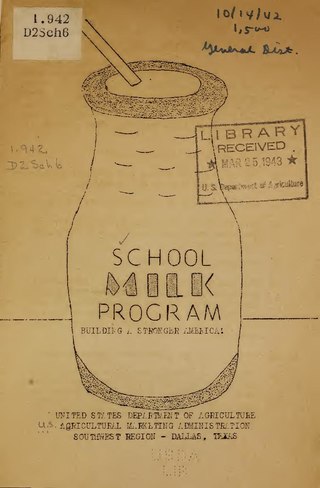
The Agricultural Adjustment Act (AAA) was a United States federal law of the New Deal era designed to boost agricultural prices by reducing surpluses. The government bought livestock for slaughter and paid farmers subsidies not to plant on part of their land. The money for these subsidies was generated through an exclusive tax on companies which processed farm products. The Act created a new agency, the Agricultural Adjustment Administration, also called "AAA" (1933-1942), an agency of the U.S. Department of Agriculture, to oversee the distribution of the subsidies. The Agriculture Marketing Act, which established the Federal Farm Board in 1929, was seen as an important precursor to this act. The AAA, along with other New Deal programs, represented the federal government's first substantial effort to address economic welfare in the United States.

The Ministry of Agriculture, Fisheries and Food (MAFF) was a United Kingdom government department created by the Board of Agriculture Act 1889 and at that time called the Board of Agriculture, and then from 1903 the Board of Agriculture and Fisheries, and from 1919 the Ministry of Agriculture and Fisheries. It attained its final name in 1955 with the addition of responsibilities for the British food industry to the existing responsibilities for agriculture and the fishing industry, a name that lasted until the Ministry was dissolved in 2002, at which point its responsibilities had been merged into the Department for Environment, Food and Rural Affairs (Defra).

The Farm Service Agency (FSA) is the United States Department of Agriculture agency that was formed by merging the farm loan portfolio and staff of the Farmers Home Administration (FmHA) and the Agricultural Stabilization and Conservation Service (ASCS). The Farm Service Agency implements agricultural policy, administers credit and loan programs, and manages conservation, commodity, disaster, and farm marketing programs through a national network of offices. The Administrator of FSA reports to the Under Secretary of Agriculture for Farm Production and Conservation. The current Administrator is Zach Ducheneaux. The FSA of each state is led by a politically appointed State Executive Director (SED).

The Canadian Wheat Board was a marketing board for wheat and barley in Western Canada. Established by the Parliament of Canada on 5 July 1935, its operation was governed by the Canadian Wheat Board Act as a mandatory producer marketing system for wheat and barley in Alberta, Saskatchewan, Manitoba, and a small part of British Columbia. It was illegal for any farmer in areas under the CWB's jurisdiction to sell their wheat and barley through any other channel than the CWB. Although often called a monopoly, it was actually a monopsony since it was the only buyer of wheat and barley. It was a marketing agency acting on behalf of Western Canadian farmers, passing all profits from its operation back to farmers. Its market power over wheat and barley marketing was referred to as the "Single Desk".
Crop insurance is insurance purchased by agricultural producers and subsidized by a country's government to protect against either the loss of their crops due to natural disasters, such as hail, drought, and floods ("crop-yield insurance", or the loss of revenue due to declines in the prices of agricultural commodities.
The Commodity Credit Corporation (CCC) is a wholly owned United States government corporation that was created in 1933 to "stabilize, support, and protect farm income and prices". The CCC is authorized to buy, sell, lend, make payments, and engage in other activities for the purpose of increasing production, stabilizing prices, assuring adequate supplies, and facilitating the efficient marketing of agricultural commodities.

The Federal Agriculture Improvement and Reform Act of 1996, known informally as the Freedom to Farm Act, the FAIR Act, or the 1996 U.S. Farm Bill, was the omnibus 1996 farm bill that, among other provisions, revises and simplifies direct payment programs for crops and eliminates milk price supports through direct government purchases.

In the United States, the farm bill is the primary agricultural and food policy instrument of the federal government. Every five years, Congress deals with the renewal and revision of the comprehensive omnibus bill.
The agricultural policy of the United States is composed primarily of the periodically renewed federal U.S. farm bills. The Farm Bills have a rich history which initially sought to provide income and price support to US farmers and prevent them from adverse global as well as local supply and demand shocks. This implied an elaborate subsidy program which supports domestic production by either direct payments or through price support measures. The former incentivizes farmers to grow certain crops which are eligible for such payments through environmentally conscientious practices of farming. The latter protects farmers from vagaries of price fluctuations by ensuring a minimum price and fulfilling their shortfalls in revenue upon a fall in price. Lately, there are other measures through which the government encourages crop insurance and pays part of the premium for such insurance against various unanticipated outcomes in agriculture.

The Agriculture and Food Act of 1981 was the 4-year omnibus farm bill that continued and modified commodity programs through 1985. It set specific target prices for 4 years, eliminated rice allotments and marketing quotas, lowered dairy supports, and made other changes affecting a wide range of USDA activities. The next year this farm bill was amended to freeze the dairy price support level and mandate loan rates and acreage reserve provisions for the 1983 crops. Again in 1984, amendments were adopted to freeze target prices, authorize paid land diversion for feed grains, upland cotton, and rice, and provide a wheat payment-in-kind program for 1984.

The Food, Agriculture, Conservation, and Trade (FACT) Act of 1990 — P.L. 101-624 was a 5-year omnibus farm bill that passed Congress and was signed into law.

The Federal Crop Insurance Reform and Department of Agriculture Reorganization Act of 1994, Pub. L. 103–354, 108 Stat. 3178, was introduced on April 14, 1994 by Eligio de la Garza (D-TX) and was signed into law on October 13, 1994 by President William J. Clinton. It consisted of two titles:

The Food Security Act of 1985, a 5-year omnibus farm bill, allowed lower commodity price and income supports and established a dairy herd buyout program. This 1985 farm bill made changes in a variety of other USDA programs. Several enduring conservation programs were created, including sodbuster, swampbuster, and the Conservation Reserve Program.
The U.S. Sugar program is the federal commodity support program that maintains a minimum price for sugar, authorized by the 2002 farm bill to cover the 2002-2007 crops of sugar beets and sugarcane.

In the United States, the Special Milk Program, sometimes known as the School Milk Program, offers federal reimbursements for milk served to children in an eligible participating outlet, which includes schools, child care institutions, settlement houses, homeless shelters, or summer camps. This federal aid program is administered by the United States Department of Agriculture (USDA) under the Food and Nutrition Service (FNS).

The Food and Agriculture Act of 1965, the first multiyear farm legislation, provided for four year commodity programs for wheat, feed grains, and upland cotton. It was extended for one more year through 1970. It authorized a Class I milk base plan for the 75 federal milk marketing orders, as well as a long term diversion of cropland under a Cropland Adjustment Program. It also continued payment and diversion programs for feed grains and cotton, and marketing certificate and diversion programs for wheat.
In United States agricultural policy, the payment limitation refers to the maximum annual amount of farm program benefits a person can receive by law.
In United States agricultural law, producers who grow a crop that is not eligible for crop insurance may be eligible for a direct payment under the Farm Service Agency’s Noninsured Crop Disaster Assistance Program (NAP). NAP has permanent authority under the Federal Crop Insurance Reform Act of 1994,.
The incentive payments are direct payments made under the National Wool Act to producers of wool and mohair, which were similar to deficiency payments made to producers of grains and cotton. The incentive payment rate was the percentage needed to bring the national average return to producers up to the annually set national support price. Each producer's direct payment was the payment rate times the market receipts. Producers with higher market receipts got larger support payments. This created an incentive to increase output and to improve quality.
A farm crisis describes times of agricultural recession, low crop prices and low farm incomes. The most recent US farm crisis occurred during the 1980s.






